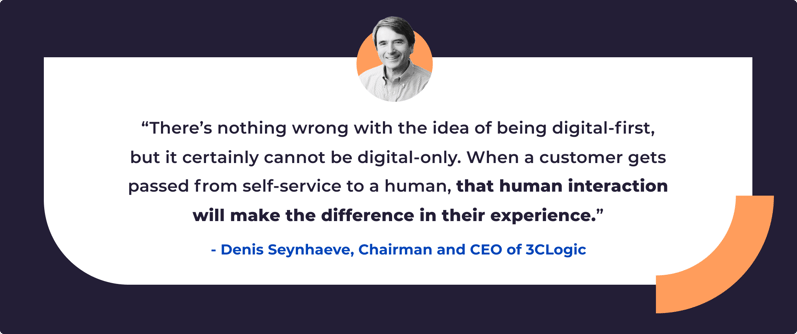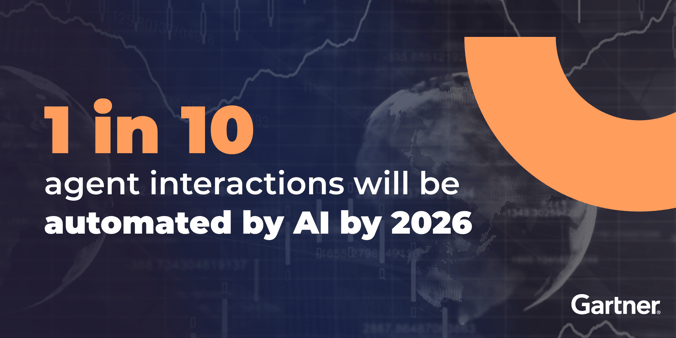AI suddenly seems unavoidable — sweeping into every sector of our lives from, ostensibly, out of nowhere. But in reality, businesses, have been leveraging applications of AI for years:
- In healthcare, machine-learning applications use algorithms to detect and interpret data patterns and help create custom treatment plans
- In manufacturing, Robotics are used to monitor and predict machine maintenance work and increase factory efficiencies
- In finance, AI can make near-immediate fraud detection decisions, as well as deliver insights on wealth management, trading, and more
Nevertheless, with the recent influx in low-code no-code AI tools that are much more accessible and user-friendly to companies large and small, business leaders are scrambling to figure out how they can use this technology to lower costs and improve efficiencies, while avoiding negative impacts to their organization. One of the most exciting frontiers in AI is in the realm of voice technology — especially for customer experience and service management.
When it comes to customer service and call center technology, an estimated 1.6% of agent interactions with customers today are automated using AI. But Gartner projects that that number is rapidly rising: by 2026, one in 10 agent interactions will be automated. The ability to leverage voice AI will be critical to gaining a competitive advantage.
So what does that mean for service management leaders and customer experience professionals? Keep reading to explore the challenges and benefits of voice AI, as well as the strategies business leaders are employing during this game-changing era to revolutionize their operations and service experiences with voice AI.
What is Voice AI?
Voice AI is a form of conversational AI that can understand, interpret, and analyze human speech, as well as produce human-like speech and interact with users.
Voice AI technologies utilize large volumes of data, machine learning, and natural language processing (NLP) and natural language understanding (NLU) to help imitate human interactions, recognizing speech and text inputs and translating their meanings across various languages.
Leveraging these technologies in turn powers incredible service tools like voice-enabled self-service, speech recognition, intelligent voice workflows, and speech analytics. In the contact center and service management industry, voice AI presents a tremendous opportunity to both receive and provide information to users in new ways, and ultimately deliver better services experiences.
The Fears Surrounding Voice AI for Business
While there are immense benefits to using these tools, AI can make many uneasy, as some assume that AI will take over all human-managed roles. In one study, 65% surveyed call center agents revealed they had considered leaving their jobs in the next two years due to fears related to AI. What these agents are missing — and what many organizations are still figuring out — is how AI could actually help make these agents’ jobs easier and more efficient, rather than replace them. More on that below.
Others may feel it will make their job harder. AI tools are not plug-and-play applications. Most require knowledgeable setup and strategic foresight to ensure proper operation, adoption, and effective use. Today, 40% of business owners lack the experience on staff to implement AI across their organization, and 28% are stuck trying to figure out where to even start.
Aside from job security and organizational issues, many have concerns with the accuracy of AI tools, and the implications that may arise. These concerns have validity — for example, Google’s speech recognition has shown to be 13% more accurate for men than it is for women, and even different English dialects have shown accuracy as low as 53%.
The crucial element is that voice AI — and all AI — must be utilized the right way. Taking a “digital first, not digital only” approach that balances voice AI tools with the human element of customer service will result in better agent performance, better service experiences, and an immense advantage over the competition.
Benefits of Voice AI for Businesses
Voice AI is already having an enormous impact on the service management industry. As organizations look to consolidate their tools and concentrate spending money on systems that will help them lower costs and streamline operations, voice AI needs to be at the top of the list. In fact, companies that adopt a future-fit technology approach — which enables great experiences for customers and employees — grow up to 2.8 times faster than their peers.
With nearly 30% of contact centers planning to implement some level of AI or machine learning within the next 12 months, it’s important to know specifically what tools and features of voice AI are the right fit for your organization, and how to properly implement, optimize, and integrate them into the systems your teams are already using.
For example, when used the right way, voice AI can create “super agents” by automating routine, manual tasks and enhancing their ability to deliver exceptional service. Companies that adopt a future-fit technology approach — which enables great experiences for customers and employees — grow up to 2.8 times faster than their peers.
Another key component of ensuring you’re getting true intelligence out of voice AI is ensuring that the tools and features you’re using are natively integrated with your system of record. Without having all your customer data — whether for customers, patients, employees, or anyone else — all in one place and readily available, your voice AI won’t have the information it needs to deliver that intelligent support.
Here are just some of the voice AI-powered tools and features that businesses can or will soon be able to leverage:
Voice-Enabled Self-Service
This go-to CX tool is rapidly evolving to deliver superior experiences with the power of voice AI. Voice self-service helps callers resolve simple issues themselves without a live agent, freeing up those same agents to focus on more complex issues. Self-service can help save massive amounts of time, in some cases leading to a 50% reduction in call duration and encourage a 20% increase in contact center productivity.
Intelligent Call Routing
Gone are the days of “dial 1 for customer service.” Voice AI can now enable callers to say exactly what they need and deliver them where they want to go. The traditional IVR system is supercharged with Voice AI workflows that can listen to callers and quickly route them to the right agent or resolve issues on the spot with voice self-service.
Real-Time Transcription & Agent Auto-Summarization Notes
Becoming a super agent with the help of AI means no more taking notes while interacting with customers on the phone or via SMS, and instead allowing for more focus on providing exceptional customer service experiences.
Script Adherence
With voice AI tracking, managers can ensure agents are sticking to their predetermined scripts, or referring back to them if calls aren’t going as planned. Integrating your call center with your system of record will make this AI tool even more powerful by having important caller data and customer context readily available for the agent to reference during the call.
Sentiment Analysis & Call Center Analytics
Organizations can easily assess a customer’s experience during and after each call with machine learning analysis of the interaction. Sentiment analysis detects customer mentions, tone, shifts in conversation topics, and anomalies for thousands of calls and automatically generates reports on what needs to be improved. Additionally, having readily-available call analytics in your system of record enables service managers to make better data-driven decisions, such as forecasting and scheduling their teams.
These tools and features are just the tip of the iceberg of what Voice AI can do. But when integrated directly into your system of record, they will make your newly crowned super agents unstoppable and ready to provide the highest level of customer service.
Balancing Voice AI with the Human Element of CX
Despite the promise of “super agents” and the benefits of properly-used voice AI tools, it cannot be overstated: today’s businesses cannot rely on AI alone. The customer’s appetite to speak to a human has never been stronger, with 82% of consumers wanting more human interaction in the future.

Those implementing voice AI tools cannot afford to take a “set it and forget it” approach. There needs to be a company-wide focus and agreement on deciding what tools are the right fit and dedication to continued updates and optimizations done by humans — which is the best way to minimize the biases that can come along with artificial intelligence.
Sentiment scoring and script adherence in particular must be continually optimized. While initial reports can help inform how customer interactions are going and how agents are performing, major decisions should not be made on what AI is providing alone. Instead of using the tool to simply tell agents what to say, it should empower them to do what they do best.
Voice AI tools can be incredibly powerful and can make organizations significantly more efficient, saving both time and money. However the balance between using technology and human empathy is essential. “There’s nothing wrong with the idea of being digital-first, but it certainly cannot be digital-only, says Denis Seynhaeve, Chairman and CEO of 3CLogic. “When a customer gets passed from self-service to a human, that human interaction will make the difference in their experience.”
Transform Your Call Center Operations with Voice AI
When implemented and operated properly, organizations have seen incredible results with the help of voice AI:
- Global automotive manufacturer Nissan reduced average caller hold time by 82% and reduced average call abandonment rate by 81% with AI-backed voice-enabled self-service
- Trusted IT company Solugenix saved 6,000 minutes in talk time per month thanks to robust and intelligent automated workflows
- Major grocery retailer Ingles Market set up a scalable agent coaching process driven by integrated speech NLP and AI improving agent scores to 88% within just 90 days after implementation
Ready to see what your organization can achieve?






